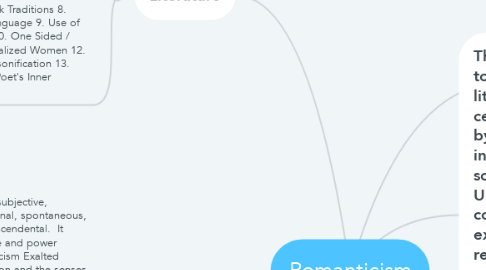Romanticism
by Agrippino Langella

1. Literature
1.1. Characteristics of the Romantic Age & Romantic Literature 1. Individuality / Democracy / Personal Freedom 2. Spiritual / Supernatural Elements 3. Nature as a Teacher 4. Interest in Past History / Ancient Greek and Roman Elements 5. Celebration of the Simple Life 6. Interest in the Rustic / Pastoral Life 7. Interest in Folk Traditions 8. Use of Common Language 9. Use of Common Subjects 10. One Sided / Opinionated 11. Idealized Women 12. Frequent Use of Personification 13. Examination of the Poet's Inner Feelings
2. Art
2.1. Romantic art was subjective, imaginative, personal, spontaneous, visionary and transcendental. It appreciated nature and power wielded. Romanticism Exalted emotion over reason and the senses over intellect. Romantic art also focused on emotions, feelings, and moods of all kinds including spirituality, imagination, mystery, and fervor. The subject matter varied widely including landscapes, religion, revolution, and peaceful beauty. The brushwork for romantic art became looser and less precise.
3. The word romanticism was first used to describe new ideas in painting and literature, towards the end of the 18th century. This word was later taken up by musicians, to describe the changes in musical style, which took place soon after the turn of the century. Unlike Classical composers, Romantic composers aimed for a store powerful expression of emotion, often revealing their innermost thoughts and feelings. Romantic music is not just about the emotion of love, it can also be about hate or death (positive or negative feelings). Many Romantic composers took an interest in art and literature:
3.1. Far off lands The distant past Dreams Night and moonlight Rivers, lakes and forests Nature and the seasons The joy and pain of love Fairy tales The supernatural Magic.
4. Music


